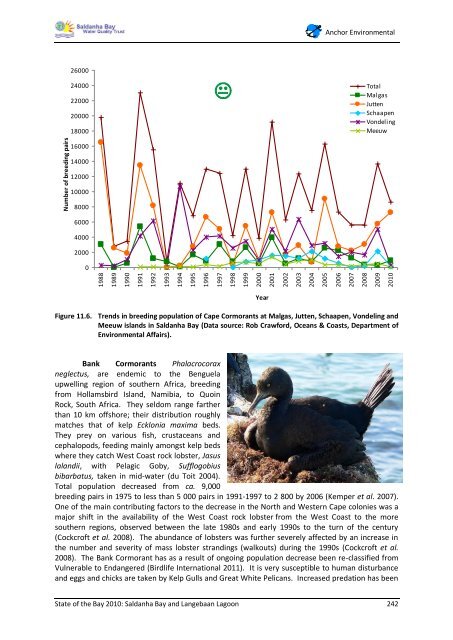State of the Bay Report 2010-Final - Anchor Environmental
State of the Bay Report 2010-Final - Anchor Environmental
State of the Bay Report 2010-Final - Anchor Environmental
You also want an ePaper? Increase the reach of your titles
YUMPU automatically turns print PDFs into web optimized ePapers that Google loves.
Number <strong>of</strong> breeding pairs<br />
26000<br />
24000<br />
22000<br />
20000<br />
18000<br />
16000<br />
14000<br />
12000<br />
10000<br />
8000<br />
6000<br />
4000<br />
2000<br />
0<br />
1988<br />
1989<br />
1990<br />
1991<br />
1992<br />
1993<br />
1994<br />
1995<br />
1996<br />
1997<br />
<strong>Anchor</strong> <strong>Environmental</strong><br />
<strong>State</strong> <strong>of</strong> <strong>the</strong> <strong>Bay</strong> <strong>2010</strong>: Saldanha <strong>Bay</strong> and Langebaan Lagoon 242<br />
1998<br />
1999<br />
2000<br />
Year<br />
2001<br />
2002<br />
2003<br />
2004<br />
2005<br />
2006<br />
2007<br />
2008<br />
Total<br />
Malgas<br />
Jutten<br />
Schaapen<br />
Vondeling<br />
Meeuw<br />
Figure 11.6. Trends in breeding population <strong>of</strong> Cape Cormorants at Malgas, Jutten, Schaapen, Vondeling and<br />
Meeuw islands in Saldanha <strong>Bay</strong> (Data source: Rob Crawford, Oceans & Coasts, Department <strong>of</strong><br />
<strong>Environmental</strong> Affairs).<br />
Bank Cormorants Phalacrocorax<br />
neglectus, are endemic to <strong>the</strong> Benguela<br />
upwelling region <strong>of</strong> sou<strong>the</strong>rn Africa, breeding<br />
from Hollamsbird Island, Namibia, to Quoin<br />
Rock, South Africa. They seldom range far<strong>the</strong>r<br />
than 10 km <strong>of</strong>fshore; <strong>the</strong>ir distribution roughly<br />
matches that <strong>of</strong> kelp Ecklonia maxima beds.<br />
They prey on various fish, crustaceans and<br />
cephalopods, feeding mainly amongst kelp beds<br />
where <strong>the</strong>y catch West Coast rock lobster, Jasus<br />
lalandii, with Pelagic Goby, Sufflogobius<br />
bibarbatus, taken in mid-water (du Toit 2004).<br />
Total population decreased from ca. 9,000<br />
breeding pairs in 1975 to less than 5 000 pairs in 1991-1997 to 2 800 by 2006 (Kemper et al. 2007).<br />
One <strong>of</strong> <strong>the</strong> main contributing factors to <strong>the</strong> decrease in <strong>the</strong> North and Western Cape colonies was a<br />
major shift in <strong>the</strong> availability <strong>of</strong> <strong>the</strong> West Coast rock lobster from <strong>the</strong> West Coast to <strong>the</strong> more<br />
sou<strong>the</strong>rn regions, observed between <strong>the</strong> late 1980s and early 1990s to <strong>the</strong> turn <strong>of</strong> <strong>the</strong> century<br />
(Cockcr<strong>of</strong>t et al. 2008). The abundance <strong>of</strong> lobsters was fur<strong>the</strong>r severely affected by an increase in<br />
<strong>the</strong> number and severity <strong>of</strong> mass lobster strandings (walkouts) during <strong>the</strong> 1990s (Cockcr<strong>of</strong>t et al.<br />
2008). The Bank Cormorant has as a result <strong>of</strong> ongoing population decrease been re-classified from<br />
Vulnerable to Endangered (Birdlife International 2011). It is very susceptible to human disturbance<br />
and eggs and chicks are taken by Kelp Gulls and Great White Pelicans. Increased predation has been<br />
2009<br />
<strong>2010</strong>

















